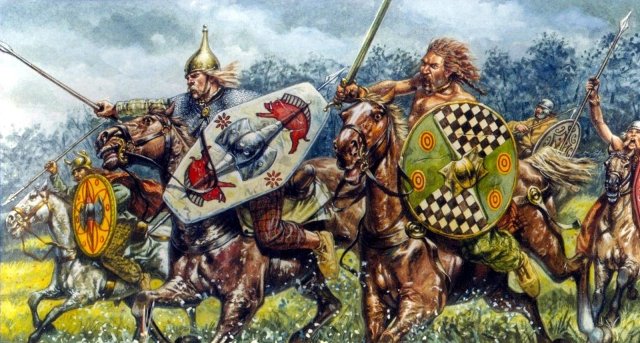
We’re heading into the wilds of Caledonia in this week’s post.
I wanted to discuss a topic that is often neglected although it is very interesting: the Picts and Pictish art.
As I’ve been packing for a move, I discovered some of my old photos from my days in St. Andrews, Scotland. I came across a packet of prints from an outing with some of my MLitt colleagues to visit Pictish sites in Angus and Perthshire.
The main attraction for us was the wide array of ornate carvings on several Pictish gravestones, most of which are maintained by Historic Environment Scotland at the Meigle Museum which is itself an old school house on the A94 Coupar Angus to Forfar road (for those of you who are interested in visiting). This little museum is a true gem and well worth a visit.
Before looking at the carvings however, I suppose I should answer one simple (or not so simple) question. Who were the Picts?
In brief, they are the direct descendants of the Caledonii, the blanket name given to those tribes who lived in the lands north of the Firth of Forth.
We hear about the latter in relation to the Roman invasion of what is now Scotland by Agricola in AD 79. The action-packed movie Centurion, with Michael Fassbender, which came out in 2010, deals with Agricola’s operations north of the Firth of Forth and the presumed disappearance of the Ninth Legion. In the film, the Caledonii/Picti are portrayed as a society run by a warrior elite, the members of which paint themselves with blue woad. The film is very entertaining, if not violent, but the best thing is that it was filmed where much of the history presumably took place. It’s worth a gander for that, if anything.
But were the Picts simply a mass of blue barbarians as they’re so often portrayed? Likely not.
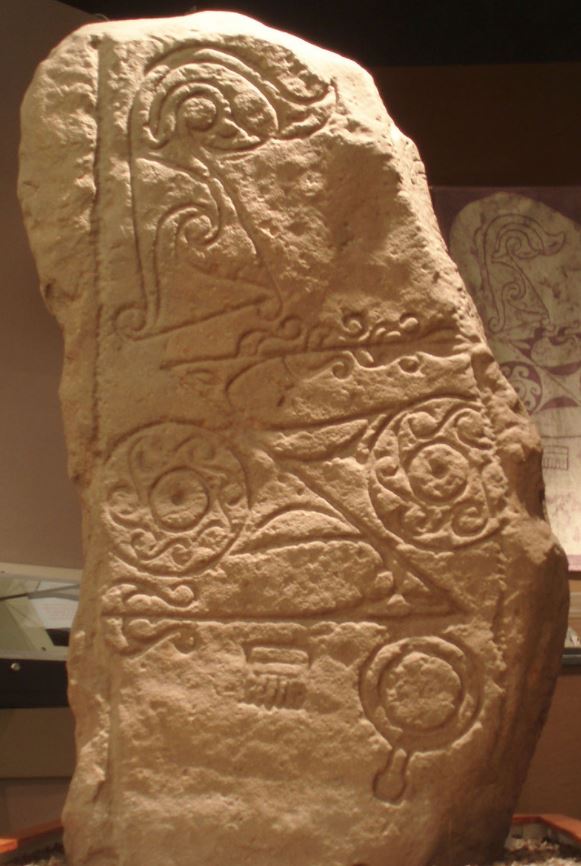
The Dunnichen Stone with typical Pictish symbols
Contrary to the usual portrayal, the Picts were not simply one enormous group living and fighting north of the Antonine Wall. They were indigenous Celts and the term ‘Picti’, like ‘Caledonii’ or ‘Maeatae’ is more of a blanket term that included approximately twelve Celtic tribes north of the Forth and Clyde rivers. These were recorded by the Roman geographer Ptolemy in the 2nd century AD. Because of the military threat posed by Imperial Rome, the Celts in the area amalgamated into two larger groups. The Caledonii and the Maeatae and, in turn, came to be later referred to as ‘Picti’.
The tribal federation survived the various Roman incursions (the last one being the Severan invasion of Scotland in the early 3rd century – the setting for Warriors of Epona). As a result the Picts were able to develop mechanisms of kingship and by the 6th century there was a Pictish kingdom.
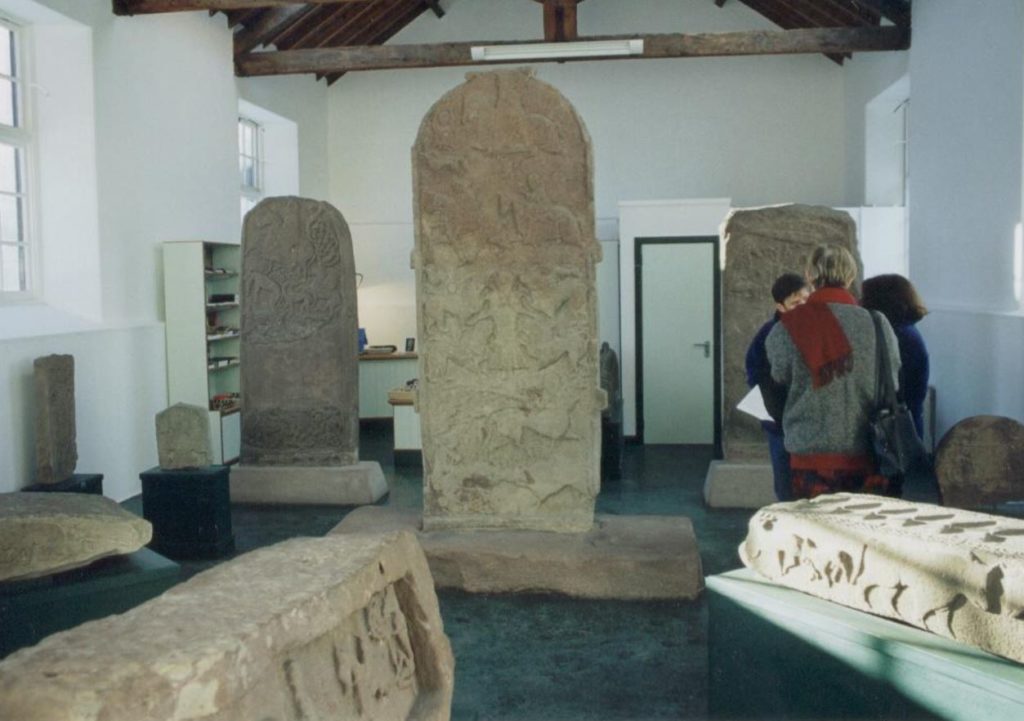
Meigle Museum – colleagues chatting with the curator
In Pictish art, there are certain recurrent symbols such as those found on the Aberlemno stone including the ‘serpent’, the ‘double-disc’, the ‘crescent’ and the ‘Z-rod’. When I visited the Meigle museum I was struck immediately by the amount of Christian imagery, having had in my mind typical images of paganism when it came to the Picts. The presence of crosses and other Christian images is due to the conversion of the Picts to Christianity after the Irish abbot of Iona, St. Columba, ventured into ‘Pictland’ in AD 565. Columba met the Pictish king, Bridei son of Maelchon in a fortress near the River Ness and thus began the conversion of the Picts, a process that was complete by about AD 700.

Artist impression of St. Columba converting the Picts
The Pictish symbol stones are one of the most important sources for information about the Picts, and the symbols, common from one end of Scotland to the other, were widely understood by all the tribes. Now, however, we know very little of their actual meaning except that they functioned as memorial stones or territorial boundary markers.
The church yard at Meigle contained a large number of Pictish stones, implying that Meigle was itself a very important centre of burial for the Pictish church and under the patronage of the kings of the Picts. Eventually however, Pictish rule, which had survived the onslaught of Rome in Late Antiquity, was taken over by the Gaelic-speaking settlers of Dalriadia (or ‘Dal Riata’ – modern Argyll) which led to the reign of the Scots King, Kenneth mac Alpin and his subsequent dynasty.
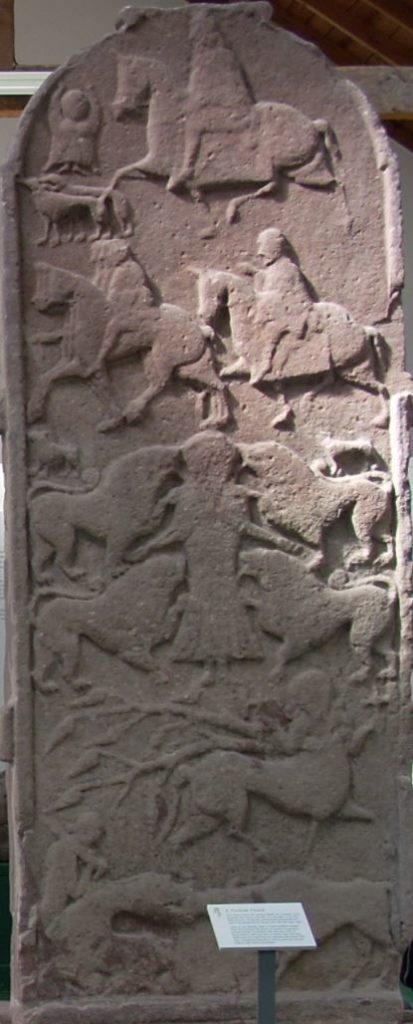
The ‘Vanora Stone’ – Cross-slab no.1 The Death of Queen Vanora
Before we bid farewell to the Picts however, there is an interesting Arthurian connection with Meigle and one of the Pictish stones (cross-slab no.1).
On entering the graveyard at Meigle, there is a grassy mound known as Vanora’s Grave. Local tradition has it that Vanora was actually Queen Guinevere, the wife of Arthur. Vanora was abducted by the Pictish king, Mordred, and held captive near Meigle. When she was returned to her husband after this forced infidelity, she was sentenced to death by being torn apart by wild beasts, hence the scene of Vanora’s death on the back of cross-slab no.1. Her remains were buried at Meigle.
Tradition also says that Vanora (and Guinevere for that matter) was barren and it is believed that any young woman who walks over her grave risks becoming barren herself. True or not, this is yet another interesting anecdote of history and legend.
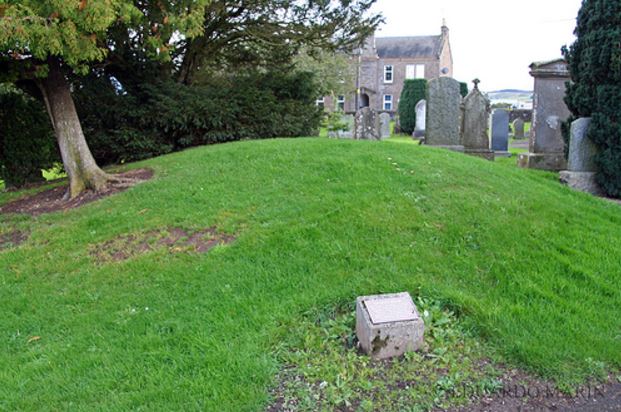
Vanora’s Grave
I hope you’ve enjoyed this post. Once more, if you ever get the chance to visit Meigle’s museum and some of the stones in the surrounding area, it’s well worth it.
Thank you for reading!
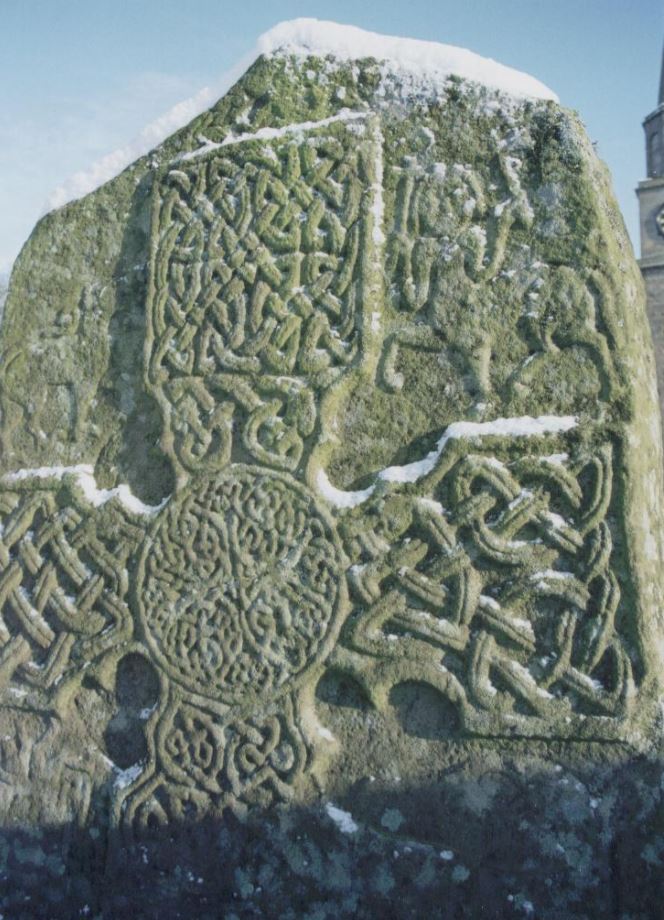
One of the Aberlemno stones



Very Useful and interesting, I have a question for you, I hop you don’t mind.
I am starting a series of TV optioned fantasy fiction, my question is…. Did the Greeks and Romans have the equivalent of court appointed Debt Collectors, such as Canada and The UK with Bailiffs ?
I know the french has Le Baillie in the Middle Ages, as did The Celts,Britons, Anglo Saxons and Danish settlers of the England (They ere responsible for collecting Were guild
Many Thanks,
Rob.
Hello Rob,
Cheers for your comment, and great question! I’ve got all of my books packed for an imminent move at the moment, and would have to do some research to give you a proper answer. Off the top of my head, I do believe both ancient Greece and Rome had some form of tax collector. I know the Roman version of a tax collector was ‘Publicanus’ – here is a quick Wikipedia definition (https://en.wikipedia.org/wiki/Publican) In a province like Britannia, say, the main ‘tax man’ would have been the Procurator, who would have hired various ‘publican’ to collect. For The Greek, I need my books 😉 If you want some great resources on things like this and everyday life in ancient Greece and Rome, I highly recommend The Handbook to life in Ancient Rome, and The Handbook to Life in Ancient Greece, both by Adkins and Adkins.
I hope this information is helpful. The TV series sounds cool – I’m interested in learning more. If there are any pages or resources on the show you’d like to share with our readers here, please let us know. Cheers and thanks for stopping by!
The concept has bee accepted and it’s working title is under wraps until my intellectual rights are registered, obviously I cannot go into the proposed project to deeply, but it has the opportunity to be set in any time period and is radically different to the expectation of the title. You have my email address and I will be looking to write any of epochs, with established writers in their areas of specialist knowledge.
If you are interested then drop me a private line.
Regards,
Rob
Sounds good, Rob. I may be in touch. Good luck with the project!
Your information is helpful. It adds to what I have learned by reading about
the Celts of Dal Raita, the first Scots under Kenneth Alpin. Their warriors held the line against the Romans. Save the stones!
Thank you Dorothy! I’m glad you found the post helpful. It is a very exciting period in Scotland’s history. So interesting! They were indeed a thorn in Rome’s side 😉 Thank you for your comment!
Hi Adam
Having been curious about the Picts and their fate fir years I founded your post very intriguing. I was especially drawn to the Vanora aspect and was wondering if there are any more references to the Arthurian legend placing him in Scotland and not in the south. Wondering if you had read Simon Stirling’s The king Arthur Conspiracy? And what your thoughts might be on his theory. Thank you fir a most interesting enjoyable post.
Hi Paula, Thank you for your comments, and I’m glad you found it interesting. The Vanora story is indeed fascinating.
Having specialized in Arthurian Studies back in my uni days, I’ve come across a lot of theories about Arthur, and many regions wanting to claim him for their own – and understandably! Trying to find the historical Arthur in all of this is like finding a particular carving on a tree in a vast and ancient forest. From the research I’ve done, I tend to lean toward a southwestern Arthur still, but I am always open to hearing new theories. I haven’t read Simon Stirling’s book, but one I have read which attempted to place Arthur in Scotland is Arthur and the Lost Kingdoms by Alistair Moffat. Here is the Goodreads link: https://www.goodreads.com/book/show/42341.Arthur_and_the_Lost_Kingdoms
Though I have my doubts about some of his theories, it is an interesting read, and fascinating to see how the Sarmatians cavalry of the Roman era may well have had a great influence (see also Howard Reid’s Arthur, the Dragon King: https://www.goodreads.com/book/show/3471952-arthur-the-dragon-king
Early next year I’ll be posting a short video series (documentary) on the theories about South Cadbury as Arthur’s ‘Camelot’. I’d also recommend Geoffrey Ashe’s Riothamus hypothesis.
With Arthur, however, there are so many theories, I don’t know that we’ll ever get to the bottom of it. ‘Truth’ eludes, but the search is so exciting, in history and fiction!
I tend to think that Arthur may have left his mark all over Britain for, as a leader of elite mounted cavalry (as a warlord or ‘Dux Bellorum’) he and his men would have been able to travel at speed to meet the enemy all over the island. So, many of the sites associated with Arthur, either in the southwest, Wales, Cumbria or Scotland may well have merit. I could go on and on…
If you have more questions, I’m happy to talk Arthur further. You can contact me via the ‘Contact’ page on this website. Cheers!
Thank you for sharing fascinating article on the Picts and another theory regarding King Arthur.
You’re very welcome, Linnea! Glad you liked this one. Thank you also for tweeting it out 🙂